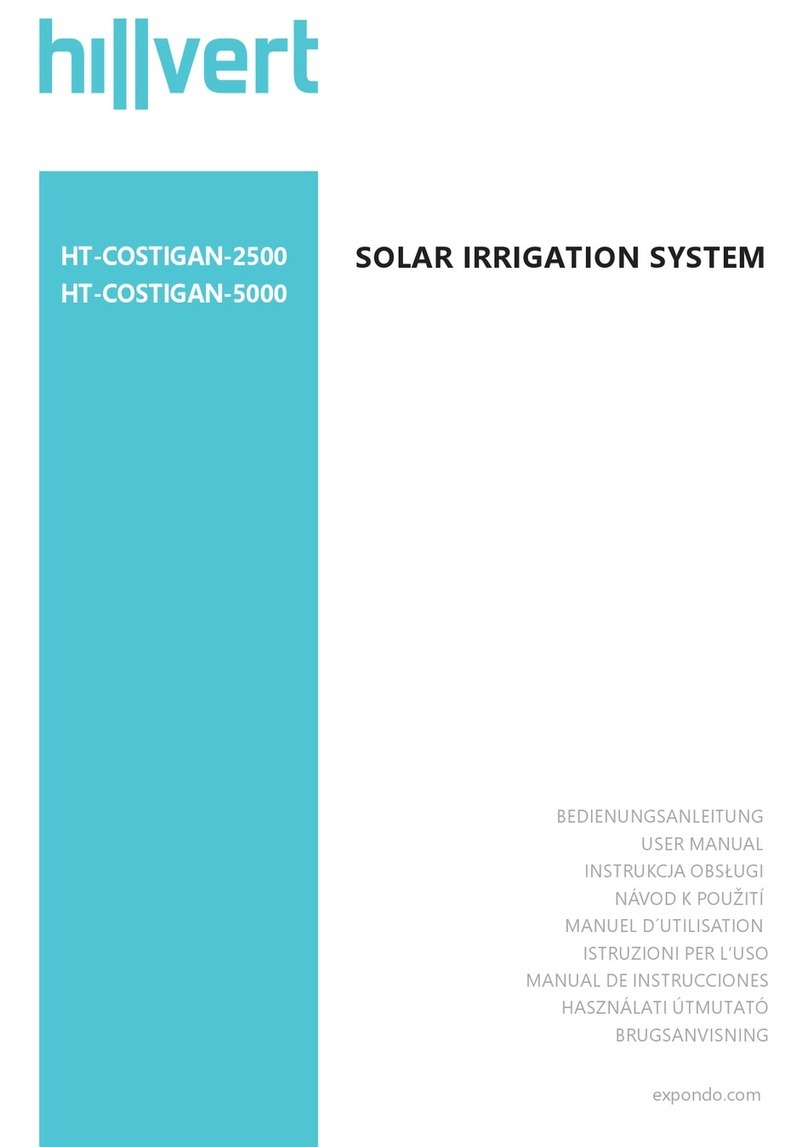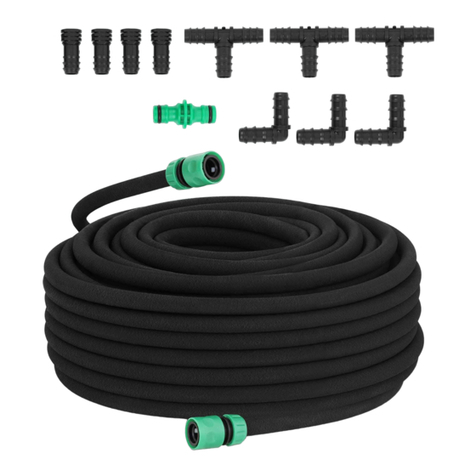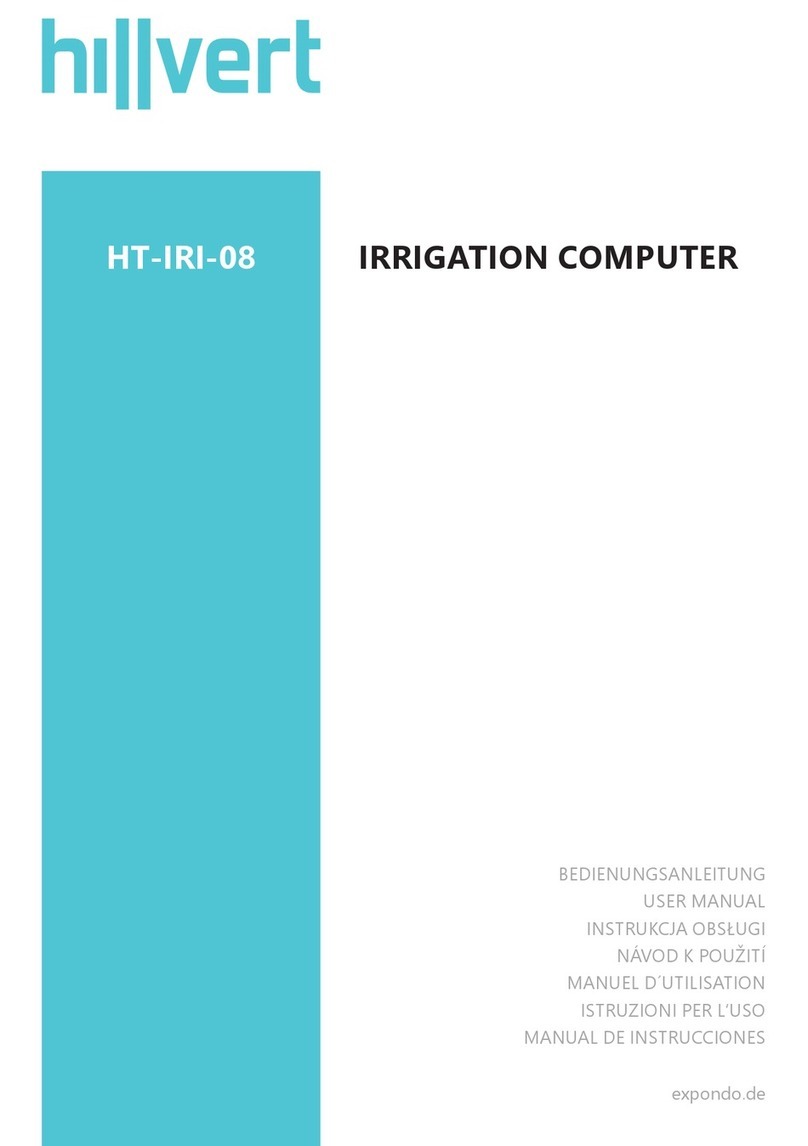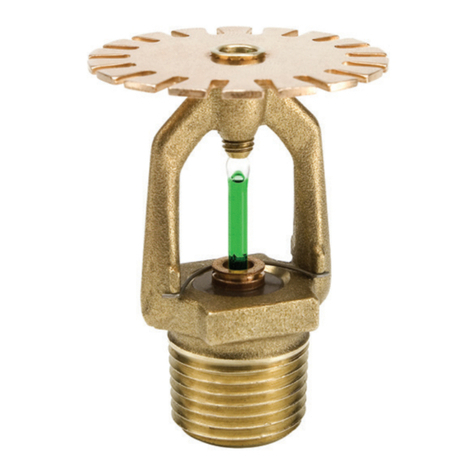
18 19
07.06.2022 07.06.2022
FR MANUEL D´UTILISATION FR
Le produit est conforme aux normes de sécurité en
vigueur.
Respectez les consignes du manuel.
Collecte séparée.
ATTENTION ! , AVERTISSEMENT ! et REMARQUE
attirent l'attention sur des circonstances
spéciques (symboles d'avertissement généaraux).
Description des paramètres Valeur des
paramètres
Nom du produit Système
d'irrigation
Modèle HT-
COSTIGAN-3600
Type d'alimentation Panneau solaire,
Pile 3,6 V
1 200 mAh Ni-MH
Puissance nominale [W] / Tension
nominale du panneau solaire[V] 0,7 / 6
Tension de la pompe [VDC] 3,5
Puissance nominale de la pompe [W] 0,45
Temps de charge de l'appareil
exposé directement au soleil [h] 6 ÷ 8
Plage de réglage de la durée de
fonctionnement pendant 12 h [min] 0,5 ÷ 12
Débit d'eau maximal [ml/min] 600
Température maximale de l'eau [°C] 40
Hauteur d'aspiration [m] 2,4
Hauteur de refoulement [m] 3
Dimensions du cadre de montage
du panneau solaire [mm] 178 × 236 × 132
Dimensions du panneau solaire [mm] 105 × 145
Dimensions de l'unité de
commande [mm] 162 × 140 × 56
Poids [kg] 1,1
An de garantir le fonctionnement able et durable de
l‘appareil, il est nécessaire d‘utiliser et d‘entretenir ce
dernier conformément aux consignes gurant dans le
présent manuel. Les caractéristiques et les spécications
contenues dans ce document sont à jour. Le fabricant se
réserve le droit de procéder à des modications à des ns
d’amélioration du produit. L‘appareil a été mis au point et
fabriqué en tenant compte des progrès techniques et de la
réduction de bruit an de réduire au maximum les risques
liés aux émissions sonores.
SYMBOLES
1. DESCRIPTION GÉNÉRALE
L‘objectif du présent manuel est de favoriser une utilisation
sécuritaire et able de l‘appareil. Le produit a été conçu
et fabriqué en respectant étroitement les directives
techniques applicables et en utilisant les technologies et
composants les plus modernes. Il est conforme aux normes
de qualité les plus élevées.
LISEZ ATTENTIVEMENT LE PRÉSENT MANUEL ET
ASSUREZ-VOUS DE BIEN LE COMPRENDRE AVANT
LA PREMIÈRE UTILISATION
DÉTAILS TECHNIQUES
Les notions d‘« appareil », de « machine » et de « produit »
gurant dans les descriptions et les consignes du manuel se
rapportent à/au Système d‘irrigation. N‘insérez ni les mains,
ni tout autre objet dans l‘appareil lorsqu‘il fonctionne !
2.1. SÉCURITÉ AU POSTE DE TRAVAIL
a) En cas de dommages ou de mauvais fonctionnement,
l’appareil doit être mis hors tension immédiatement
et la situation doit être rapportée à une personne
compétente.
b) En cas d’incertitude quant au fonctionnement correct
de l’appareil, contactez le service client du fabricant.
c) Seul le service du fabricant peut eectuer des
réparations. Ne tentez aucune réparation par vous-
même !
d) Conservez le manuel d’utilisation an de pouvoir
le consulter ultérieurement. En cas de cession de
l’appareil à un tiers, l’appareil doit impérativement
être accompagné du manuel d’utilisation.
e) Les câbles électriques et les tuyaux d‘irrigation
doivent être disposés de manière à ne pas menacer
la sécurité des personnes et à éviter les risques de
trébuchement.
f) Vériez régulièrement l’absence de dommages et de
fuites sur les tuyaux.
g) Ne pliez pas les câbles pour éviter de les
endommager.
h) N‘utilisez pas l‘appareil à proximité d‘installations
électriques pour éviter de les mouiller. Cela peut
constituer une menace pour la vie et la santé.
i) Pensez à remplir régulièrement l’eau du réservoir
pour empêcher la pénétration d‘air dans le système.
j) Ne branchez pas l‘appareil directement au réseau
d‘alimentation en eau existant.
k) Ne branchez jamais l‘appareil à une source
d‘alimentation autre qu‘un panneau solaire
compatible.
La version originale de ce manuel a été rédigée en
allemand. Toutes les autres versions sont des traductions
de l‘allemand.
2. CONSIGNES DE SÉCURITÉ
REMARQUE !Les illustrations contenues dans le
présent manuel sont fournies à titre explicatif. Votre
appareil peut ne pas être identique.
ATTENTION !Veuillez lire attentivement toutes
les consignes de sécurité et toutes les instructions.
Le non-respect des avertissements et des consignes
de sécurité peut entraîner des blessures graves ou
la mort.
REMARQUE !Veillez à ce que les enfants et les
personnes qui n‘utilisent pas l‘appareil soient en
sécurité durant le travail.
2.2. SÉCURITÉ DES PERSONNES
a) N‘utilisez pas l‘appareil lorsque vous êtes fatigué,
malade, sous l‘eet de drogues ou de médicaments
et que cela pourrait altérer votre capacité à utiliser
l‘appareil.
b) Cet appareil n‘est pas conçu pour être utilisé
par les personnes dont les facultés physiques,
C
D
AB
H
IK
F
E
J
G
L
sensorielles ou mentales sont limitées (enfants y
compris), ni par des personnes sans expérience
ou connaissances adéquates, à moins qu‘elles se
trouvent sous la supervision et la protection d‘une
personne responsable ou qu‘une telle personne leur
ait transmis des consignes appropriées en lien avec
l‘utilisation de l’appareil.
c) An de prévenir la mise en marche accidentelle de
l‘appareil, assurez-vous que celui-ci est éteint et que
l‘interrupteur se trouve sur arrêt avant de procéder
au branchement.
d) Cet appareil n‘est pas un jouet. Les enfants doivent
demeurer sous la supervision d’un adulte an qu’ils
ne jouent pas avec l’appareil.
2.3. UTILISATION SÉCURITAIRE DE L‘APPAREIL
a) Ne faites pas surchauer l‘appareil. Utilisez les outils
appropriés pour l‘usage que vous en faites. Le choix
d‘appareils appropriés et l‘utilisation soigneuse de
ceux-ci produisent de meilleurs résultats.
b) N’utilisez pas l’appareil si l’interrupteur MARCHE/
ARRÊT ne fonctionne pas correctement. Les appareils
qui ne peuvent pas être contrôlés à l‘aide d‘un
interrupteur sont dangereux et doivent être réparés.
c) Avant de procéder à tout réglage, changement
d‘accessoire ou dépose, débranchez l’appareil du
panneau solaire. Une telle mesure préventive réduit
le risque d‘activation accidentelle.
d) Les outils qui ne sont pas en cours d‘utilisation
doivent être mis hors de portée des enfants et des
personnes qui ne connaissent ni l‘appareil, ni le
manuel d‘utilisation s‘y rapportant. Entre les mains
de personnes inexpérimentées, ce genre d‘appareils
peut représenter un danger.
e) Maintenez l‘appareil en parfait état de marche. Avant
chaque utilisation, vériez l’absence de dommages
en général et au niveau des pièces mobiles (assurez-
vous qu’aucune pièce ni composant n’est cassé et
vériez que rien ne compromet le fonctionnement
sécuritaire de l’appareil). En cas de dommages,
l’appareil doit impérativement être envoyé en
réparation avant d’être utilisé de nouveau.
f) Tenez l‘appareil hors de portée des enfants.
g) La réparation et l‘entretien des appareils doivent être
eectués uniquement par un personnel qualié, à
l‘aide de pièces de rechange d‘origine. Cela garantit
la sécurité d’utilisation.
h) Pour garantir l‘intégrité opérationnelle de l‘appareil,
les couvercles et les vis posés à l‘usine ne doivent pas
être retirés.
i) Il est défendu de pousser, de déplacer ou de tourner
l’appareil pendant son fonctionnement.
j) Nettoyez régulièrement l‘appareil pour en prévenir
l’encrassement.
k) Cet appareil n‘est pas un jouet. Le nettoyage et
l’entretien ne doivent pas être eectués par des
enfants, à moins qu’ils se trouvent sous la supervision
d’un adulte responsable.
l) Ne déplacez pas l‘appareil en le tenant par les ls ou
les tuyaux et ne le suspendez pas non plus de cette
façon.
m) Il est interdit d‘utiliser l‘appareil pour pomper de
l‘eau contaminée (par exemple par de l‘huile, des
particules, des solides abrasifs, etc.).
n) Il est interdit d‘utiliser l‘appareil pour le pompage
d‘eau salée, de substances corrosives, de liquides
inammables, etc.
o) Il est interdit d‘utiliser l‘appareil à des températures
sous zéro. L‘eau gelée endommagera l‘appareil.
p) Ne démarrez pas l‘appareil à sec.
q) Montez le panneau solaire de manière à le protéger
contre les dommages accidentels (résultant par
exemple d‘une chute ou d‘un choc).
ATTENTION ! Bien que l‘appareil ait été conçu en
accordant une attention spéciale à la sécurité et qu‘il
comporte des dispositifs de protection, ainsi que des
caractéristiques de sécurité supplémentaires, il n’est
pas possible d’exclure entièrement tout risque de
blessure lors de son utilisation. Nous recommandons
de faire preuve de prudence et de bon sens lorsque
vous utilisez l’appareil.
ATTENTION ! Les schémas du produit se trouvent à
la dernière page du manuel d’utilisation (p. 30).
3. CONDITIONS D’UTILISATION
L‘appareil est conçu pour irriguer automatiquement les
plantes en utilisant l‘énergie solaire. L’utilisateur porte
l’entière responsabilité pour l’ensemble des dommages
attribuables à un usage inapproprié.
3.1. DESCRIPTION DE L‘APPAREIL
A. Tuyau à grande section
B. Tuyau à petite section
C. Unité de commande
D. Panneau solaire avec piquet
E. Capteur de niveau d‘eau
F. Filtre
G. Buse d‘arrosage
H. Support de tuyau
I. Connecteur T2
J. Connecteur T1
K. Bouchon
L. Valve anti-siphon
ATTENTION ! Au point « Montage de l‘appareil », vous
trouverez une description de la façon appropriée de couper
les tuyaux (A) et (B) !
3.2 MONTAGE DE L‘APPAREIL
Nomenclatur :
A1. Tuyau d‘aspiration
A2. Tuyau d‘alimentation
B1. Tuyau de distribution































